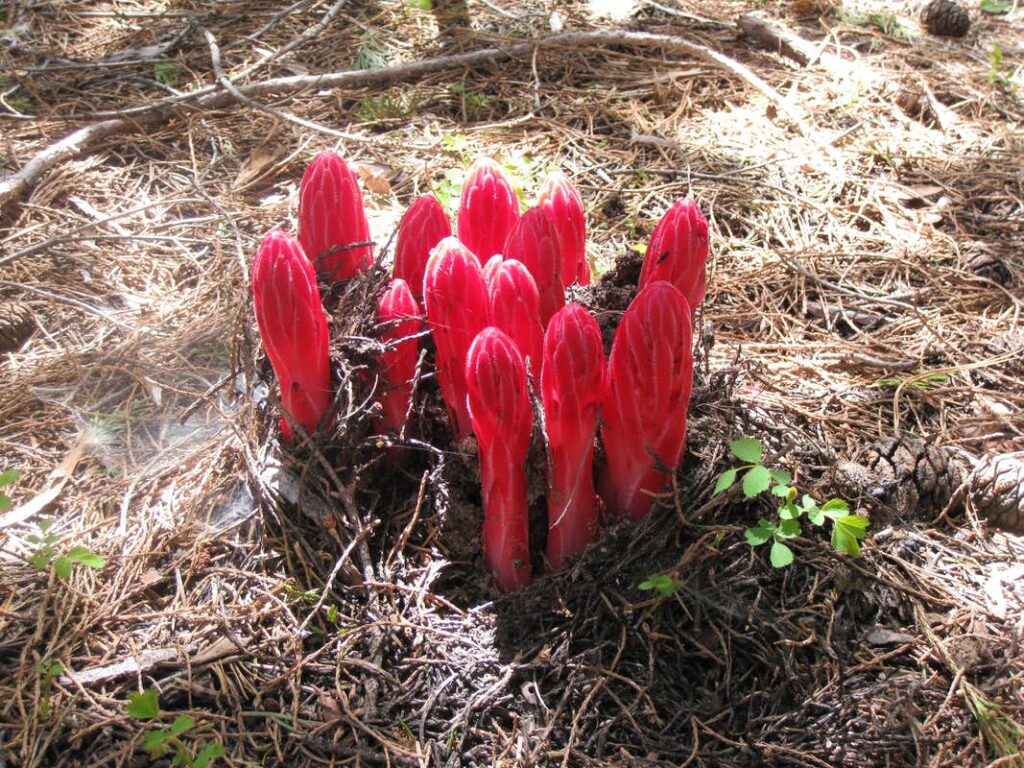http://www.summitpost.org/heterotrophic-plants/591392
Plants generally make their own food through the process of photosynthesis. These plants are called autotrophs (self-feeding). However, some species have taken a different route for nourishment. These plants, called heterotrophs (other feeding), lack chlorophyll and cannot make their own food. Such plants can be recognized as lacking any green parts and are often succulent to some degree. The most common groups of plants that do this are some orchids and monotropes, which are a sub-group of the Heath family, Ericaceae. Ericaceae is a well known and diverse family including blueberries, rhododendrons, wintergreen and many others, which are quite different from the monotropes to the degree that some taxonomic treatments separate them out in their own family, Monotropaceae. Most of the monotropic plants in the North America occur in the west.
Based on how they obtain their food, there are two main categories of non-green, non-photosynthetic, heterotrophic plants.
The first group of plants is parasitic on other plants for their food. As parasites, they obtain their nourishment from a host green plant directly through the use of root structures called haustoria. Examples of such parasitic plants include the ground cone, squawroot and all members of the broomrape family, Orobanchaceae.
The second group includes the fungus feeding plants or mycotrophic plants. These plants utilize an intermediary mycorrhizal fungus that attaches to the roots of a green host plant, often a tree. This much larger group of non-green plants includes some orchids and the monotropes. Previously, mycotrophic plants were considered saprophytes or plants that derive their nutrients from decaying organic matter. The relationship between these plants and the soil fungi is now better understood. The plants tap into the fungus and receive water and nutrients that were shared between the fungus and tree. For this reason, this group of plants is often considered epiparasites. Some plants such as some members of the genus Pyrola generally have green leaves, but occasionally are leafless forms and thus heterotrophic.
Indian Pipe is a parasitic plant that generally grows near pine. It is perfectly white, lacking the chlorophyll that creates the green in most plants. It turns black and dies as fall approaches.
Snow Plant (Sarcodes sanguinea) on the Vetter Mountain Trail. This plant is native to Southern California and is considered a mycoparasite. They are parasites on fungi, but they don’t kill the fungi. The roots of the Snow Plant contain fungi which extend into the conifer forest leaf litter in which Snow Plant grows. The Snow Plant is fed water and nutrients from the fungi. These fungi also extend into the roots of pines and other conifers.
Indian Pipe (Monotropa uniflora) in the woods of Middlesex Fells outside Boston.
This is an angiosperm (flowering plant) which has lost its chloroplasts and adopted a lifestyle more typical of fungi: it feeds only through its roots and emerges from the soil only for the sake of reproduction. Ironically, it parasitises fungi which themselves colonize tree roots.
Believe it or not, Indian Pipe is classified in the heath family (Ericacae) along with blueberries and rhododendrons.
Usually Indian Pipe is pure white, but pink specimens like this one are not too rare. A deep red variety also exists, but I’ve never seen it.
The phantom orchid (Eburophyton austiniae) is a rare species that grows in the mountains near the Pacific Coast with disjunct populations in the northern Rocky Mountains, mostly Idaho. It has a faint vanilla smell. Photo taken in Clearwater County, Idaho.
Spotted coralroot (Coralorhiza maculata) is a widespread, but fairly uncommon orchid in the western U.S. Photo was taken north of Clear Lake, CA. May 2009








